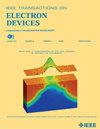An Electrothermally Actuated Microshutter Array With Enhanced Power Efficiency for Intelligent Lighting Control
IF 2.9
2区 工程技术
Q2 ENGINEERING, ELECTRICAL & ELECTRONIC
引用次数: 0
Abstract
With the rapid development of smart vehicles and unmanned driving, intelligent lighting control systems that can generate programmable illumination patterns are attracting great attention. In this work, an electrothermally actuated rolling shutter array is proposed to realize intelligent automobile headlights. A用于智能照明控制的电热致动微型快门阵列具有更高的能效
随着智能汽车和无人驾驶的快速发展,能够产生可编程照明模式的智能照明控制系统备受关注。本研究提出了一种电热致动卷帘阵列来实现智能汽车前大灯。我们设计并制造了一个 2times 8$ 的电热微快门阵列。芯片尺寸为 26×26×0.5 毫米,有效光学孔径为 20×20 毫米。滚动快门上的电阻加热器是用一种新提出的方法设计的,以实现均匀的温度分布。为了提高功率效率,采用了聚酰亚胺(PI)填充沟槽来增加热隔离,从而降低了工作电压和功耗。实验结果表明,单个微快门像素的打开率从 0 V(开态)时的 71% 变为 2.8 V(关态)时的 2.6%。从打开到关闭的开关功率效率为 9.1 mW/mm2,对应于 2times 8$ 微快门阵列在关闭状态下的最大功耗为 3.65 W。此外,还成功演示了模拟交通场景,微型快门阵列可为模型车提供可编程照明。
本文章由计算机程序翻译,如有差异,请以英文原文为准。
求助全文
约1分钟内获得全文
求助全文
来源期刊

IEEE Transactions on Electron Devices
工程技术-工程:电子与电气
CiteScore
5.80
自引率
16.10%
发文量
937
审稿时长
3.8 months
期刊介绍:
IEEE Transactions on Electron Devices publishes original and significant contributions relating to the theory, modeling, design, performance and reliability of electron and ion integrated circuit devices and interconnects, involving insulators, metals, organic materials, micro-plasmas, semiconductors, quantum-effect structures, vacuum devices, and emerging materials with applications in bioelectronics, biomedical electronics, computation, communications, displays, microelectromechanics, imaging, micro-actuators, nanoelectronics, optoelectronics, photovoltaics, power ICs and micro-sensors. Tutorial and review papers on these subjects are also published and occasional special issues appear to present a collection of papers which treat particular areas in more depth and breadth.
 求助内容:
求助内容: 应助结果提醒方式:
应助结果提醒方式:


